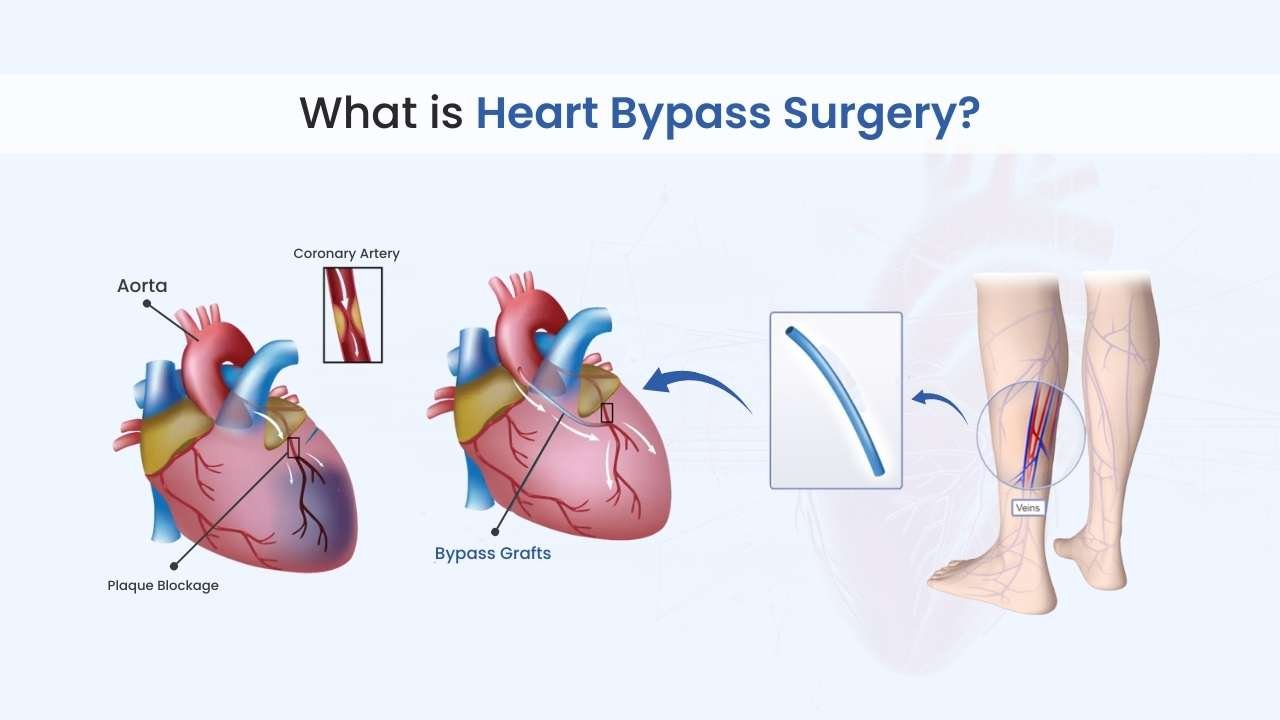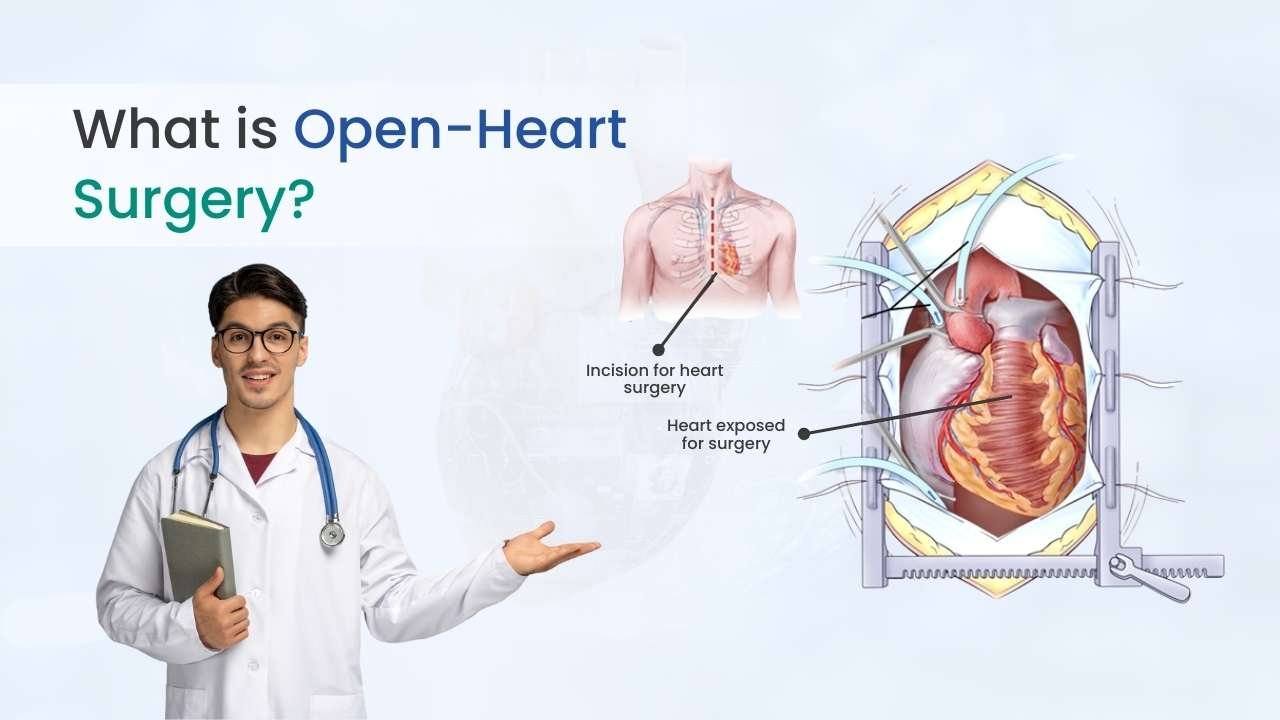Home Blogs Cardiac Surgery Understanding the Difference Between Bypass and Open Heart Surgery

Understanding the difference between bypass surgery and open-heart surgery is an important aspect; however, they have different purposes. Open-heart surgery means any procedure where the chest is opened, even if the heart itself isn’t. This surgery can involve work on the heart’s muscles, valves, and arteries. Bypass surgery is a specific type of open-heart surgery where a healthy blood vessel from the chest or leg is connected to a blocked coronary artery. This new route helps blood to bypass the blockage and reach the heart. While bypass surgery is typically done through open-heart surgery, it can also be performed using less invasive methods. Other kinds of open-heart surgeries include coronary angioplasty and heart transplants.
One major difference between bypass and open-heart surgery is:
Open-heart surgery involves cutting the chest to reach the heart directly, and this surgery works on different parts of your heart, like muscles, valves, and arteries. Sometimes, the heart itself may stay closed, but the surgery still takes place inside your chest.
In bypass surgery, the doctor takes a healthy blood vessel from your chest or leg and connects it to the artery in the heart that has a blockage, creating a new path for blood to flow. It can be done in two ways: either through open-heart surgery or using less invasive techniques that require smaller cuts. Both surgeries have their advantages and benefits, and the choice depends on your condition.

Heart bypass surgery is an operation in which doctors open your chest to reach your heart, and it is done to create a new path for blood to flow around blocked and narrowed arteries. In this, the surgeon takes a healthy blood vessel from another part of your body and connects it between the aorta and a point beyond the blockage in your artery.
Usually, one of the blood vessels used is an artery from your chest, called the internal mammary artery. Other vessels can come from your leg or your arm.
You may need a single bypass if one artery is blocked, or a double bypass if two arteries are blocked. If three arteries are blocked, you will need a triple bypass, and if four arteries are blocked, you will need a quadruple bypass.
The most common conditions are serious heart artery disease. People who may need CABG often have one or more of these problems:
• Severe Blockages in the Heart Arteries
When several blood vessels in your heart are badly blocked, the heart muscle doesn’t get enough oxygen-rich blood.
• Angioplasty Didn’t Work
When other treatments, such as placing a stent or undergoing angioplasty, fail and are not suitable for the patient.
• Major Block in the Left Main Artery
When the main artery that supplies blood to the left side of your heart is narrowed or blocked.
• Severe Chest Pain (Angina)
Ongoing chest pain and discomfort that doesn’t get better with medicines and other treatments.
The open-heart method is still common and often preferred. However, knowing the difference between bypass and open-heart surgery shows that some patients may benefit more from less invasive options.
In a traditional bypass surgery, the surgeon makes a large cut in your chest and temporarily stops the heart. To reach the heart, the surgeon cuts the sternum in half and gently spreads it apart. Tubes are then placed in your heart so that a heart-lung machine can keep blood and oxygen flowing through the body while the surgery is being done.
While the open-heart method is still common and often preferred, newer and less invasive techniques are also available to treat blocked heart arteries, including:
‣ You Should Follow Your Doctor’s Advice
‣ Increase Activity Slowly
‣ Manage Pain
‣ Eat a Heart-Healthy Diet
‣ Stay Hydrated
‣ Avoid Smoking and Alcohol
‣ Watch for Complications
Open-heart surgery involves cutting open your chest and performing surgery on the heart’s muscles, valves, and arteries. Caring for yourself and your incision after surgery can help minimize some risks. It’s also useful to know the difference between bypass and open-heart surgery.

Open-heart surgery is a type of operation to treat heart problems by opening your chest and operating directly on the heart.
In this surgery, the doctor cuts through the breastbone and gently spreads the ribs apart to reach the heart. It is used to treat several heart problems, such as:
Open-heart surgery is sometimes done to perform a Coronary Artery Bypass Graft (CABG). It may be needed if a person has coronary heart disease, a condition in which the blood vessels that supply blood and oxygen to your heart become narrow and stiff.
This narrowing happens because fatty substances build up inside the artery walls, and this process is called atherosclerosis.
When the arteries are blocked and narrowed, blood can’t flow well to the heart, which can cause chest pain, heart attacks, and heart failure.
Doctors may also do open-heart surgery to:
Heart surgery is done to treat different heart problems, and the type of surgery you need depends on your specific heart problem, your age, your overall health, and other personal factors.
Below are the most common heart problems that may require surgery:
⦿ Aneurysm
An aortic aneurysm is a swelling in the aorta (the main artery that carries blood from your heart to your body). Normally, the aorta has strong, thick walls. But health problems and injuries can weaken these walls. When the walls are weak, the pressure of blood can make them bulge, which can be dangerous if not treated.
⦿ Arrhythmias
Arrhythmias are problems with how fast and slow your heart beats or if it beats in an irregular pattern. If medicines and other treatments don’t work, doctors may do surgery to put a small device inside your body to control the heartbeat. These devices include pacemakers and implantable cardioverter defibrillators (ICDs).
⦿ Atrial Fibrillation
Atrial fibrillation is a very common type of arrhythmia, which means your heart is beating irregularly and not working as smoothly as it should.
⦿ Coronary Heart Disease
Coronary heart disease happens when the blood vessels that supply blood to your heart get narrowed and blocked. If this is serious, you may need coronary artery bypass grafting (CABG), also known as heart bypass surgery, to improve blood flow to your heart.
⦿ Heart Failure
Heart failure means the heart is not pumping enough blood to your body. This can happen if the heart doesn’t fill up with enough blood and if it’s too weak to pump blood properly.
⦿ Heart Valve Disease
The heart has valves that make sure blood flows in the right direction, and if these valves don’t open and close properly, blood flow inside your heart is affected. In such cases, the valves may need to be repaired and replaced.
⦿ Heart Valve Repair Surgery
Surgeons can repair valves in different ways depending on the problem, for example:
◾ Coronary Artery Bypass Grafting (CABG)
CABG is the most common type of heart surgery. In this procedure, the surgeon takes a healthy blood vessel from another part of your body and attaches it to the heart so blood can flow around a blocked artery. Sometimes, more than one blocked artery is bypassed during the same surgery is also called heart bypass surgery or coronary artery bypass surgery.
◾ Heart Valve Repair and Replacement
If a heart valve is damaged, the surgeon can either fix it or replace it. Replacement valves can be man-made and made from pig, cow, and human heart tissue. One repair method uses a thin tube inserted into a blood vessel, helping it to the heart. A small balloon at the tip is inflated and deflated to widen a narrow valve.
◾ Pacemaker and Implantable Cardioverter Defibrillator (ICD) Placement
For irregular heartbeats, medicines are usually tried first; if they don’t work, a pacemaker can be placed under the skin of your chest and stomach. It’s connected to the heart with wires and sends small electrical signals to keep the heartbeat normal. An ICD works like a pacemaker but can also send a quick electric shock to fix dangerous rhythms.
◾ Maze Surgery
This surgery treats an irregular heartbeat known as atrial fibrillation. The surgeon makes small cuts in the upper chambers. These cuts help the heart’s electrical signals along a proper path, stopping them from causing irregular beats.
◾ Ventricular Assist Device (VAD) and Total Artificial Heart (TAH)
A VAD is a machine that helps the heart pump blood when it’s too weak, and a TAH replaces the heart’s two lower chambers completely, taking over their pumping function.
Important Things to Know About Your Recovery After Open-Heart Surgery:
‣ Your Eating Habits Might Change
‣ Tips:
‣ You Might Have Trouble Sleeping
It’s common to have trouble sleeping after heart surgery because of the anesthesia, discomfort, changes in your routine, and stress. Most people start sleeping normally again in 2-3 weeks.
‣ Tips for Better Sleep:
‣ You May Feel Emotional
Recovery takes both physical and emotional energy, and many people feel emotional ups and downs after surgery, but this is normal. These feelings can last for weeks and even a few months.
‣ Common Feelings:
Open heart surgery and Bypass surgery are complex surgeries that are done to treat heart problems. However, there are a few distinctions between bypass and open-heart surgery:
Heart Bypass | Open Heart Surgery |
A heart bypass is a type of surgery that takes a blood vessel from another part of your body and uses it to create a new path around a blocked artery in your heart. | Open-heart surgery is performed by cutting through the breastbone to reach your heart, and this procedure is used to treat various heart problems. |
The recovery time after open-heart surgery is 4 weeks and and 2-3 weeks after heart bypass surgery as well.
The hospital stay after open heart surgery is 8 days; however hospital stay after bypass surgery is 7 days.
✅ Foods to Avoid After Bypass and Open-Heart Surgery
✅ Healthy Foods to Add to Your Diet
✅ Lifestyle Changes
After heart surgery, you may face challenges, but you also have the chance to live a healthier life. To improve your recovery and support your heart health in the long run, follow a heart-healthy diet, join a rehabilitation program, and make important lifestyle changes.
FAQs
No, they are not the same; open-heart surgery means the chest is opened to reach the heart. Whereas Bypass surgery is a specific type of surgery where blocked arteries are treated by creating a new path for blood to flow.
The cost of open-heart surgery in India is 4500 USD.
It’s called a bypass because the surgeon makes a new path for blood to go around the blocked and narrow arteries in your heart, which helps blood flow normally again.
No, you won’t feel any pain during the surgery because you’ll be under general anesthesia. After surgery, you may feel some discomfort, soreness, and tiredness. Doctors will give you pain medicines to help you feel better.
The risks of open-heart surgery include bleeding, infection, blood clots, and potential heart rhythm problems, arrhythmias, and stroke.
Yes, in some cases, doctors can use minimally invasive surgery, where they make small cuts instead of opening the entire chest. This means faster recovery and less pain.
Yes, many people live 20 years or more after the surgery, especially if they take care of their heart health.
The cost of bypass surgery in India is 5000 USD.
Bypass surgery lowers your risk of a heart attack in the future. Still, the risk is slightly higher during the first month after surgery. You should follow your doctor’s advice to help reduce this risk.
After open-heart surgery, patients usually spend 24 hours or less in the ICU. However, the exact duration can depend on individual recovery and the specific procedure. Some patients may stay longer, while others might be moved to a regular hospital room sooner.

Written By
Hi! I’m Shafaq Khan, a content writer at Mejocare.com, where I create simple, easy-to-understand healthcare content. With 1+ years of experience, my goal is to make health topics clear and helpful for everyone, no matter their background.
At Mejocare, I focus on turning complicated medical information into content that’s both informative and easy to read. Whether I’m writing blog posts, articles, or website copy, I aim to provide useful information that helps people take control of their health and connect with the right healthcare providers.
I’m passionate about helping people access reliable health information in a way that’s easy to understand and act on. If you’d like to connect or have any questions, feel free to reach out!
SOURCE
HISTORY
At Mejocare, we prioritize accuracy and reliability. Our content is based on peer-reviewed studies, academic research, and medical associations. We avoid tertiary references. Learn more in our editorial policy. Trustworthy health information for you.
https://www.eternalhospital.com/title/difference-between-bypass-surgery-and-open-heart-surgery para 1, 2 https://www.bhf.org.uk/informationsupport/treatments/coronary-bypass-surgery para 1, 2, 3 https://www.kauveryhospitalsbangalore.com/blog/the-benefits-of-cabg para 3 https://www.kauveryhospitalsbangalore.com/blog/recovery-after-cabg para 2, 3,4,5,6,7,8 https://www.healthline.com/health/open-heart-surgery para 1 https://www.pennmedicine.org/treatments/open-heart-surgery para 1 https://www.nhlbi.nih.gov/health/heart-surgery/conditions para 1,2,3,4,5,6,7 https://madeforthismoment.asahq.org/preparing-for-surgery/procedures/heart-surgery/ para 2,3,4,5,8 https://www.michiganmedicine.org/health-lab/recovering-open-heart-surgery-6-things-expect para 2,3,5 https://www.healthline.com/health/bypass-vs-open-heart-surgery para 2,3 https://www.tgh.org/institutes-and-services/treatments/surgical-bypass para 4,5 https://www.livasahospitals.com/blog/life-after-heart-surgery-dietary-guidelines-lifestyle-changes 4,5,6,7,9,10
CURRENT VERSION
Our care team can help you.
